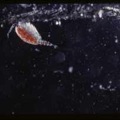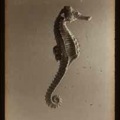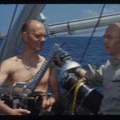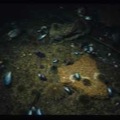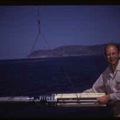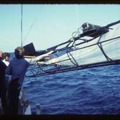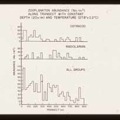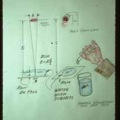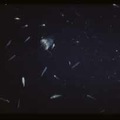Marine Biology
by Claire Calcagno
Doc Edgerton describes how he was first drawn to the challenges of underwater instrumentation by a marine biologist who needed underwater lights and cameras to document luminescent fish, in the later 1930s. While this first effort was not fully successful in producing legible images, Doc was immediately tantalized by the potential of underwater research: as he put it, underwater photography had the unique capacity to reveal “a host of items unsuspected and illuminate a variety of others which for long have resided in the limbo of half-knowledge”. He went on to assist marine biologists in their scientific inquiries in a broad variety of ways.
A fundamental problem about photographing the underwater world was how to record selected objects of interest on the sea bottom or in the open sea. With biological organisms that were mobile and often frightened by lights, this problem was compounded. Initially, images of organisms captured on film were recorded by chance, and it was not always possible to determine the depth at which their picture had been taken – not very useful documentation for biologists studying habitats and ecologies. Doc’s sonar positioning systems would play a crucial role in adding meaning to these efforts, to relay information about where and when an image was triggered to the scientists on board the research ship at the surface.
Early on Doc designed a system which he prosaically called an interruption camera, by which a passing animal would interrupt a light beam and thereby trigger the camera shutter and its associated flash illumination to take its picture. In the early 1940s he thought to apply underwater high-speed motion cameras to tracking the rapid movement of marine organisms such as the seahorse, opening a new avenue of locomotor research to the underwater realm.
For slow-motion organisms he delighted people with his underwater time-lapse photography of seemingly static organisms such as sea urchins, sand dollars and starfish, which he researched with Kenneth Read in the later 1960s. These tools also provided important data for scientists examining the biological reworking of sediments: that is, sea bottom erosion caused by marine organisms.
In the late 1950s Doc designed a successful luminescence camera together with L. R. Breslau, for working down to depths of 6,000 m.: the luminescent flashing of marine organisms would trigger a deep-sea underwater camera and thus take pictures of the animals producing the flashes. And with his silhouette photography cameras, which he began experimenting with during his expeditions with Jacques Cousteau in the 1950s, Edgerton assisted scientists in studying live marine micro-organisms in their natural habitat. Scientists such as Peter B. Ortner were finally able to quantify and distinguish micro-organism populations living at sea. A laboratory-based system Doc developed was also valuable, in which micro-organisms are placed directly on light sensitive film emulsion, and the photograph is exposed by using a tiny electronic flash; where the organism is translucent enough, the flash can reveal its internal structure.
Doc marveled that with his deep-sea lights and cameras designed to withstand the enormous pressures of the depths, he could find and reveal animals that had been inaccessible before – as he put it, that had never cast a shadow, let alone seen light.






